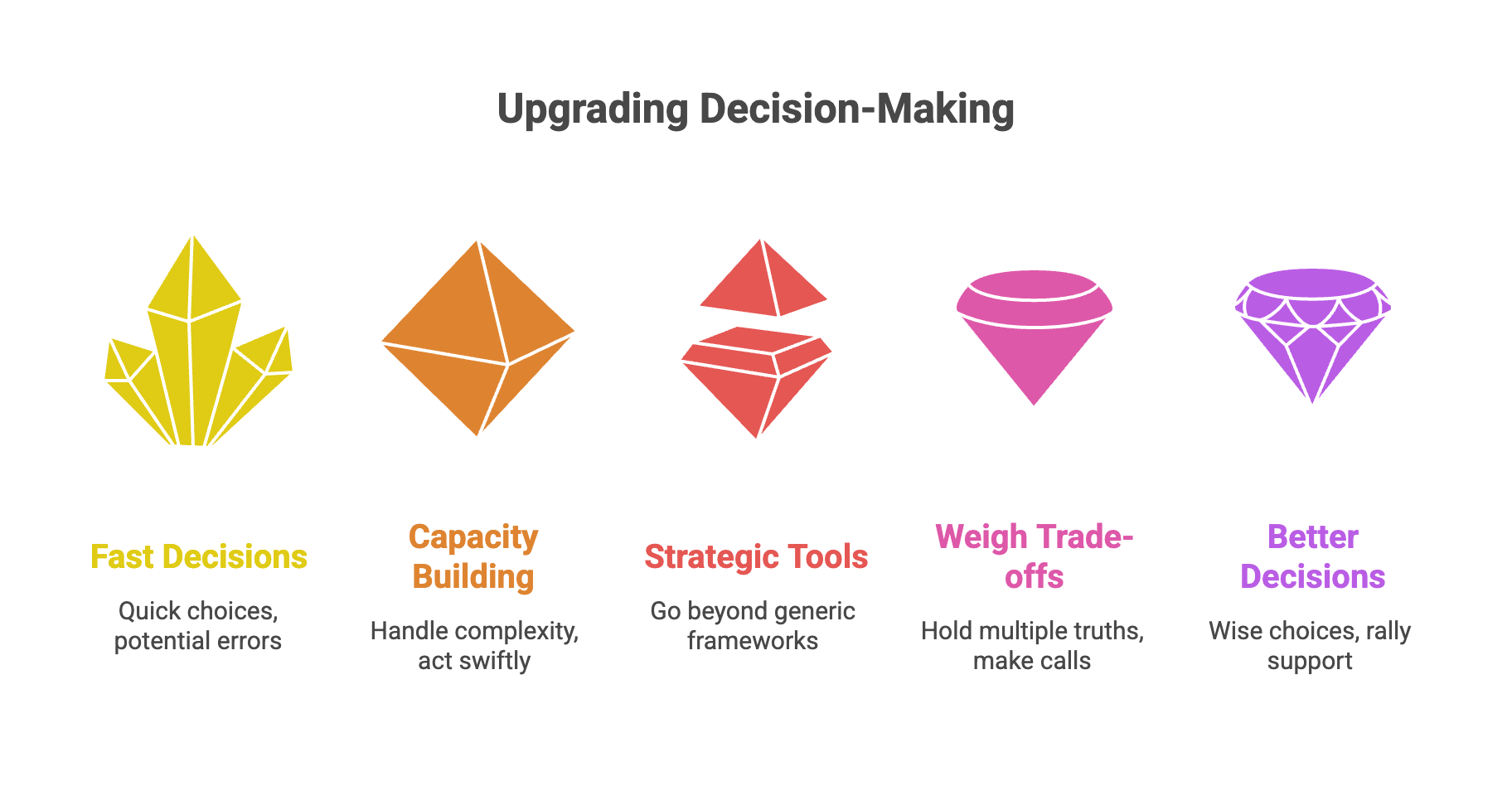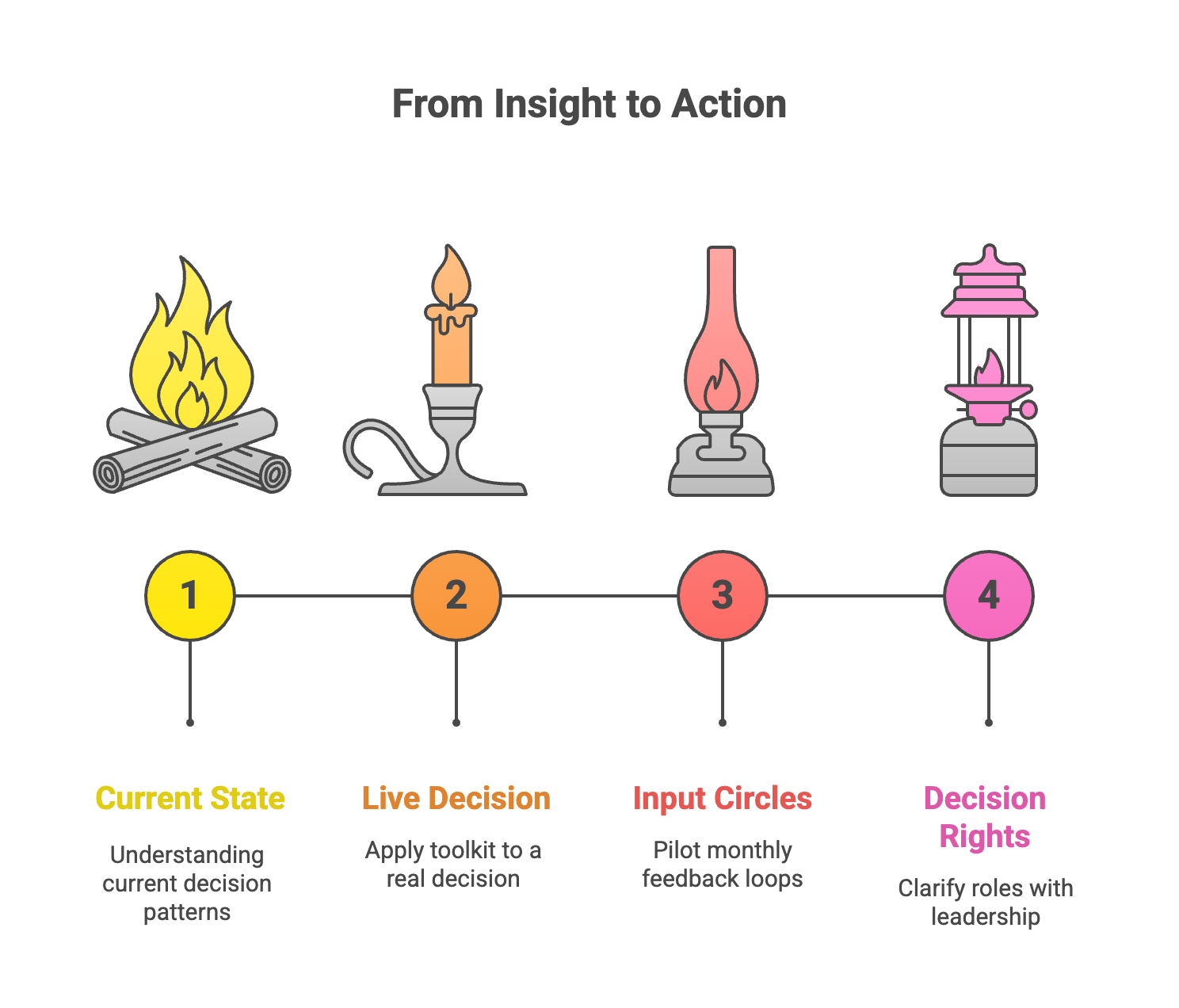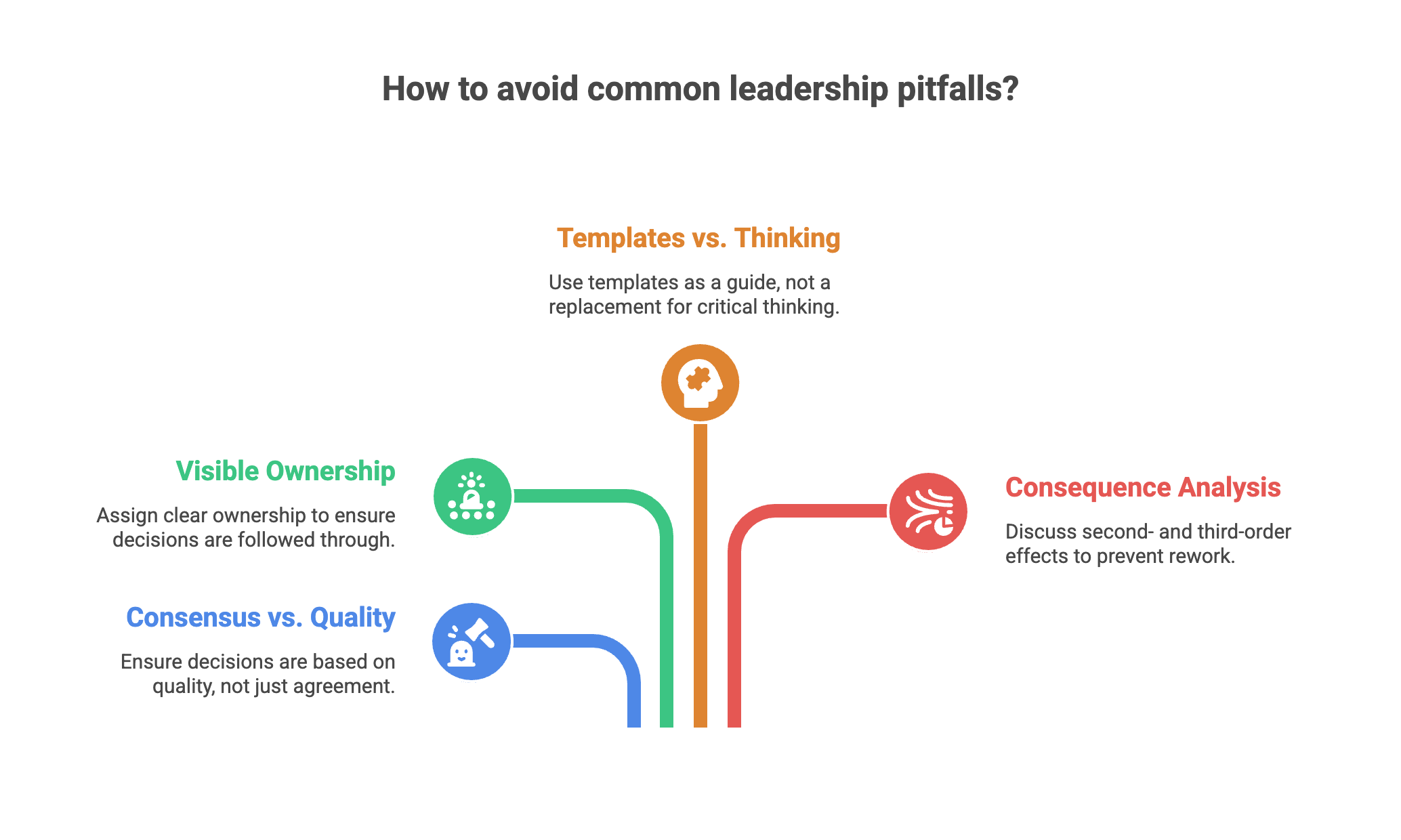Decision Making
July 25, 2025
6
Min
Upgrading Executive Decision-Making: Leadership Tools That Actually Shift the Game
Leadership
|
That’s the tension we often walk into. Senior teams proud of their agility, but quietly haunted by a series of near misses: a high-potential hire that didn’t work out, an expansion that stretched the culture too thin, or a strategic pivot made just a quarter too early.
In today’s pressure-soaked operating climate, decision-making isn’t just a competence issue - it’s a capacity issue. We’re expected to choose wisely, act swiftly, and course-correct gracefully, all while navigating complexity that defies intuition.
So how do we actually upgrade our decision-making muscles - not just tinker around the edges?
Let’s unpack the leadership development tools that go beyond generic frameworks, and instead help senior leaders do what they’re really on the hook for: holding multiple truths, weighing ambiguous trade-offs, and making judgment calls that others can rally behind.

In a study published by McKinsey, organisations with high-quality decision-making processes were six times more likely to report superior financial performance. Not faster decision-making. Not more decisive leadership. Better decisions.
This matters because decision-making is where leadership gets real. Strategies mean nothing if leaders can’t choose well in real time, with limited data and competing priorities.
Yet most leadership development efforts underinvest here. They prioritise skills like communication, resilience, and influence - valuable, yes, but rarely decisive in the boardroom or at the strategy table.
We use a five-part framework we call The Decision Upgrade Toolkit - a leadership development suite aimed at levelling up executive judgment under real-world conditions.
Every leader has a “decision signature” - a habitual pattern shaped by experience, risk tolerance, and cultural conditioning. Some over-consult. Some over-rely on instinct. Others default to data, even when none of it is decisive.
We help leaders name and unpack their decision profile using a short reflective tool built around four archetypes:
Knowing your type isn’t about labelling. It’s about recognising your blind spots in high-stakes calls.
Prompt: When under pressure, what do I prioritise - speed, certainty, consensus, or control?
Micro-action: Schedule a 20-minute decision audit with a trusted peer. Analyse your last three big decisions - what drove your process?
This tool sounds deceptively simple: Insert a deliberate pause between recognising a problem and acting on the first solution. We call this technique The Strategic Wait.
Why it matters: Seasoned leaders often misdiagnose problems accurately - but solve the wrong layer. They reach for quick fixes because their experience tells them “this is just like last time.”
The Strategic Wait gives space to ask: “What’s actually being decided here?” That shift alone can reposition a tactical fix as a strategic inflection point.
Micro-action: In your next exec team huddle, identify one issue that deserves a 48-hour pause. Use that window to test for deeper patterns.
This is about training what we call Second-Order Thinking. It’s the difference between asking “What will this do?” versus “What might this lead to over time?”
We use a cascading exercise where leaders map:
This lens is particularly potent for product launches, pricing changes, restructures, and tech investments.
Prompt: What might this create that we haven’t consciously chosen?
Micro-action: Before signing off on a major initiative, lead a 15-minute session with your team to sketch the second-order map.
By the time most senior decisions surface, the conversation’s already narrowed. Leaders bring proposals, not raw questions. Yet great decisions are born upstream - where disagreement is still possible.
We teach execs to use Input Circles - fast, structured conversations where a leader brings a half-formed problem to a mix of insiders and contrarians for input before shaping their recommendation.
The goal: Build range, not reach consensus. Train your team to probe, not nod.
Micro-action: Once a month, run an Input Circle with 3-4 colleagues outside your team. Pose a live, uncomfortable trade-off you’re facing.
Finally, decision-making isn’t solo sport. Organisations that decide well have rituals and rhythms that help decisions travel faster, land cleaner, and stick longer.
We call this Collective Decision Readiness - and it includes tools like:
It’s not sexy work. But it’s what separates high-functioning leadership teams from charismatic but chaotic ones.
Prompt: Where is a decision logjam happening right now - and what structural clarity is missing?
Micro-action: Run a 1-hour “decision mapping” session with your team: Who decides what? Who needs input? Who is over-involved?

Pro Tip: Don’t introduce this as a training programme. Introduce it as a way to de-risk today’s top three decisions.

Confusing consensus with quality. Just because everyone agrees doesn’t mean it’s the right call.
Avoiding visible ownership. Decisions without visible sponsorship tend to fizzle.
Relying on templates over thinking. Frameworks support judgment - they don’t replace it.
Skimming the consequence surface. If the second- and third-order effects aren’t discussed, expect rework.

Prompt 1: Which recent decision drained the most energy - and what about the process made it harder than it needed to be?
Prompt 2: In what area of your leadership are you making too many decisions others should own?
When leaders develop stronger decision muscles, we see cascading effects:
And perhaps most importantly: Better decisions mean fewer regrets. Not just in results, but in how we lead.
This week, choose one decision you’re about to make - and run it through the full toolkit. Even just once. Use the insights to tweak your next team rhythm, adjust a role’s decision rights, or reshape how your executive huddles surface input.
Want help customising these tools for your context? We’d love to share examples or walk through your team’s live decisions. Reach out.
Team SHIFT
Is your leadership team truly making better decisions - or just faster ones?
That’s the tension we often walk into. Senior teams proud of their agility, but quietly haunted by a series of near misses: a high-potential hire that didn’t work out, an expansion that stretched the culture too thin, or a strategic pivot made just a quarter too early.
In today’s pressure-soaked operating climate, decision-making isn’t just a competence issue - it’s a capacity issue. We’re expected to choose wisely, act swiftly, and course-correct gracefully, all while navigating complexity that defies intuition.
So how do we actually upgrade our decision-making muscles - not just tinker around the edges?
Let’s unpack the leadership development tools that go beyond generic frameworks, and instead help senior leaders do what they’re really on the hook for: holding multiple truths, weighing ambiguous trade-offs, and making judgment calls that others can rally behind.

In a study published by McKinsey, organisations with high-quality decision-making processes were six times more likely to report superior financial performance. Not faster decision-making. Not more decisive leadership. Better decisions.
This matters because decision-making is where leadership gets real. Strategies mean nothing if leaders can’t choose well in real time, with limited data and competing priorities.
Yet most leadership development efforts underinvest here. They prioritise skills like communication, resilience, and influence - valuable, yes, but rarely decisive in the boardroom or at the strategy table.
We use a five-part framework we call The Decision Upgrade Toolkit - a leadership development suite aimed at levelling up executive judgment under real-world conditions.
Every leader has a “decision signature” - a habitual pattern shaped by experience, risk tolerance, and cultural conditioning. Some over-consult. Some over-rely on instinct. Others default to data, even when none of it is decisive.
We help leaders name and unpack their decision profile using a short reflective tool built around four archetypes:
Knowing your type isn’t about labelling. It’s about recognising your blind spots in high-stakes calls.
Prompt: When under pressure, what do I prioritise - speed, certainty, consensus, or control?
Micro-action: Schedule a 20-minute decision audit with a trusted peer. Analyse your last three big decisions - what drove your process?
This tool sounds deceptively simple: Insert a deliberate pause between recognising a problem and acting on the first solution. We call this technique The Strategic Wait.
Why it matters: Seasoned leaders often misdiagnose problems accurately - but solve the wrong layer. They reach for quick fixes because their experience tells them “this is just like last time.”
The Strategic Wait gives space to ask: “What’s actually being decided here?” That shift alone can reposition a tactical fix as a strategic inflection point.
Micro-action: In your next exec team huddle, identify one issue that deserves a 48-hour pause. Use that window to test for deeper patterns.
This is about training what we call Second-Order Thinking. It’s the difference between asking “What will this do?” versus “What might this lead to over time?”
We use a cascading exercise where leaders map:
This lens is particularly potent for product launches, pricing changes, restructures, and tech investments.
Prompt: What might this create that we haven’t consciously chosen?
Micro-action: Before signing off on a major initiative, lead a 15-minute session with your team to sketch the second-order map.
By the time most senior decisions surface, the conversation’s already narrowed. Leaders bring proposals, not raw questions. Yet great decisions are born upstream - where disagreement is still possible.
We teach execs to use Input Circles - fast, structured conversations where a leader brings a half-formed problem to a mix of insiders and contrarians for input before shaping their recommendation.
The goal: Build range, not reach consensus. Train your team to probe, not nod.
Micro-action: Once a month, run an Input Circle with 3-4 colleagues outside your team. Pose a live, uncomfortable trade-off you’re facing.
Finally, decision-making isn’t solo sport. Organisations that decide well have rituals and rhythms that help decisions travel faster, land cleaner, and stick longer.
We call this Collective Decision Readiness - and it includes tools like:
It’s not sexy work. But it’s what separates high-functioning leadership teams from charismatic but chaotic ones.
Prompt: Where is a decision logjam happening right now - and what structural clarity is missing?
Micro-action: Run a 1-hour “decision mapping” session with your team: Who decides what? Who needs input? Who is over-involved?

Pro Tip: Don’t introduce this as a training programme. Introduce it as a way to de-risk today’s top three decisions.

Confusing consensus with quality. Just because everyone agrees doesn’t mean it’s the right call.
Avoiding visible ownership. Decisions without visible sponsorship tend to fizzle.
Relying on templates over thinking. Frameworks support judgment - they don’t replace it.
Skimming the consequence surface. If the second- and third-order effects aren’t discussed, expect rework.

Prompt 1: Which recent decision drained the most energy - and what about the process made it harder than it needed to be?
Prompt 2: In what area of your leadership are you making too many decisions others should own?
When leaders develop stronger decision muscles, we see cascading effects:
And perhaps most importantly: Better decisions mean fewer regrets. Not just in results, but in how we lead.
This week, choose one decision you’re about to make - and run it through the full toolkit. Even just once. Use the insights to tweak your next team rhythm, adjust a role’s decision rights, or reshape how your executive huddles surface input.
Want help customising these tools for your context? We’d love to share examples or walk through your team’s live decisions. Reach out.
Team SHIFT
Is your leadership team truly making better decisions - or just faster ones?
That’s the tension we often walk into. Senior teams proud of their agility, but quietly haunted by a series of near misses: a high-potential hire that didn’t work out, an expansion that stretched the culture too thin, or a strategic pivot made just a quarter too early.
In today’s pressure-soaked operating climate, decision-making isn’t just a competence issue - it’s a capacity issue. We’re expected to choose wisely, act swiftly, and course-correct gracefully, all while navigating complexity that defies intuition.
So how do we actually upgrade our decision-making muscles - not just tinker around the edges?
Let’s unpack the leadership development tools that go beyond generic frameworks, and instead help senior leaders do what they’re really on the hook for: holding multiple truths, weighing ambiguous trade-offs, and making judgment calls that others can rally behind.

In a study published by McKinsey, organisations with high-quality decision-making processes were six times more likely to report superior financial performance. Not faster decision-making. Not more decisive leadership. Better decisions.
This matters because decision-making is where leadership gets real. Strategies mean nothing if leaders can’t choose well in real time, with limited data and competing priorities.
Yet most leadership development efforts underinvest here. They prioritise skills like communication, resilience, and influence - valuable, yes, but rarely decisive in the boardroom or at the strategy table.
We use a five-part framework we call The Decision Upgrade Toolkit - a leadership development suite aimed at levelling up executive judgment under real-world conditions.
Every leader has a “decision signature” - a habitual pattern shaped by experience, risk tolerance, and cultural conditioning. Some over-consult. Some over-rely on instinct. Others default to data, even when none of it is decisive.
We help leaders name and unpack their decision profile using a short reflective tool built around four archetypes:
Knowing your type isn’t about labelling. It’s about recognising your blind spots in high-stakes calls.
Prompt: When under pressure, what do I prioritise - speed, certainty, consensus, or control?
Micro-action: Schedule a 20-minute decision audit with a trusted peer. Analyse your last three big decisions - what drove your process?
This tool sounds deceptively simple: Insert a deliberate pause between recognising a problem and acting on the first solution. We call this technique The Strategic Wait.
Why it matters: Seasoned leaders often misdiagnose problems accurately - but solve the wrong layer. They reach for quick fixes because their experience tells them “this is just like last time.”
The Strategic Wait gives space to ask: “What’s actually being decided here?” That shift alone can reposition a tactical fix as a strategic inflection point.
Micro-action: In your next exec team huddle, identify one issue that deserves a 48-hour pause. Use that window to test for deeper patterns.
This is about training what we call Second-Order Thinking. It’s the difference between asking “What will this do?” versus “What might this lead to over time?”
We use a cascading exercise where leaders map:
This lens is particularly potent for product launches, pricing changes, restructures, and tech investments.
Prompt: What might this create that we haven’t consciously chosen?
Micro-action: Before signing off on a major initiative, lead a 15-minute session with your team to sketch the second-order map.
By the time most senior decisions surface, the conversation’s already narrowed. Leaders bring proposals, not raw questions. Yet great decisions are born upstream - where disagreement is still possible.
We teach execs to use Input Circles - fast, structured conversations where a leader brings a half-formed problem to a mix of insiders and contrarians for input before shaping their recommendation.
The goal: Build range, not reach consensus. Train your team to probe, not nod.
Micro-action: Once a month, run an Input Circle with 3-4 colleagues outside your team. Pose a live, uncomfortable trade-off you’re facing.
Finally, decision-making isn’t solo sport. Organisations that decide well have rituals and rhythms that help decisions travel faster, land cleaner, and stick longer.
We call this Collective Decision Readiness - and it includes tools like:
It’s not sexy work. But it’s what separates high-functioning leadership teams from charismatic but chaotic ones.
Prompt: Where is a decision logjam happening right now - and what structural clarity is missing?
Micro-action: Run a 1-hour “decision mapping” session with your team: Who decides what? Who needs input? Who is over-involved?

Pro Tip: Don’t introduce this as a training programme. Introduce it as a way to de-risk today’s top three decisions.

Confusing consensus with quality. Just because everyone agrees doesn’t mean it’s the right call.
Avoiding visible ownership. Decisions without visible sponsorship tend to fizzle.
Relying on templates over thinking. Frameworks support judgment - they don’t replace it.
Skimming the consequence surface. If the second- and third-order effects aren’t discussed, expect rework.

Prompt 1: Which recent decision drained the most energy - and what about the process made it harder than it needed to be?
Prompt 2: In what area of your leadership are you making too many decisions others should own?
When leaders develop stronger decision muscles, we see cascading effects:
And perhaps most importantly: Better decisions mean fewer regrets. Not just in results, but in how we lead.
This week, choose one decision you’re about to make - and run it through the full toolkit. Even just once. Use the insights to tweak your next team rhythm, adjust a role’s decision rights, or reshape how your executive huddles surface input.
Want help customising these tools for your context? We’d love to share examples or walk through your team’s live decisions. Reach out.
Team SHIFT
